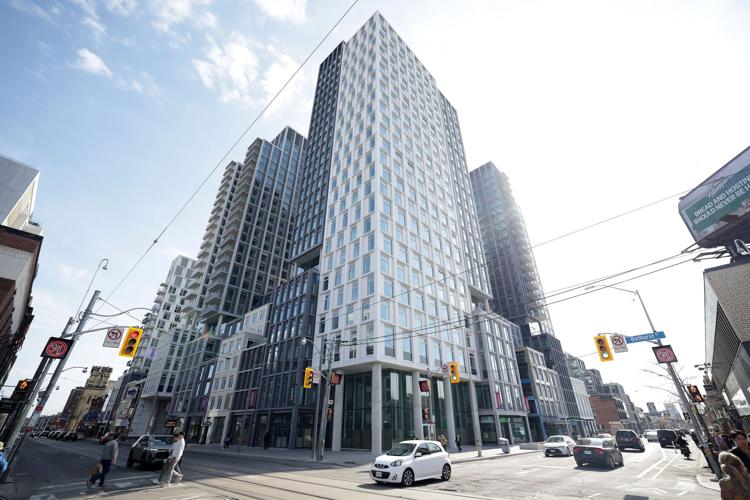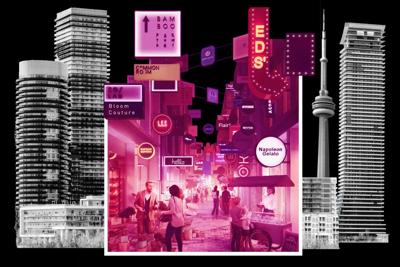At Bloor and Bathurst, where landmark discount store Honest EdÔÇÖs once stood, thereÔÇÖs an inviting streetscape reminiscent of the buzzing back alleys of Tokyo.╠ř
A flower shop, a whimsical gelato cart and a dive bar with a neon sign are among the shops lining a narrow street packed with╠řpeople.
But the scene is not real, not yet anyway.
ItÔÇÖs a rendering ÔÇö part of an advertisement at a new under-construction housing and commercial site╠řlooking for “creative businesses” to lease “move-in ready micro retail units.”
That’s the promised future on the corner, currently occupied by recently╠řfinished╠řgrey and white towers, a handful of bigger stores, and a few bright pink ÔÇťMirvish VillageÔÇŁ signs.
Across Toronto,╠řcherished pubs, restaurants or dry cleaners have been torn down to make way for new developments.╠řBut what ends up replacing them in ground floor retail spaces of the towers are often chains, which risk╠řturning TorontoÔÇÖs distinct neighbourhoods into uniform concrete blocks of Shoppers Drug Marts, Rexalls and fast-food franchises.
These spaces may have long been an afterthought, but there’s a growing acknowledgment of the value smaller establishments provide╠řto the life of a street.
- Manuela Vega
Some developers, such as Mirvish Villages’ Westbank and the Daniels Corp.╠řat Regent Park, are trying to do things differently, despite challenges such as floor plans and financing. It’s also something Toronto’s new chief planner says he wants to work on.
There seems to be a recent shift in thinking, said╠řDaniel Rotsztain, managing director of urban space organization plazaPOPS, which works╠řto preserve small establishments╠řin suburban plazas targeted for redevelopment, “To say, ‘OK, how do we create the ecosystems that support these in the future, if we’re seeing their eradication in this ‘Shoppers-ification’╠řof our beloved businesses?’”
Making room for community and local businesses space can draw more people to a project, he said, as well as increase buy-in.

Grey and white towers have replaced the old Honest Ed’s store at Bloor and Bathurst streets.
Steve Russell/pc28╣┘═°StarAt╠řMirvish Village, encompassing the original department store site and surrounding area, Westbank has designed a whole new destination.╠ř
Although plagued by delays, there’s a planned food hall and live music venue, a daycare, a public park, and the restoration of heritage homes on Markham street for retail. That goes along with 890 residential rentals, a good chunk of them under market rent.
All of that, along with the envisioned “Honest EdÔÇÖs Alley,” illustrates╠řan example of how to build the density the city╠řneeds without losing the neighbourhoods we love.
Why condo developers often go big box
Avi Behar, CEO of the Behar Group of companies and╠řa commercial real estate broker╠řworking to find retail tenants for╠řMirvish Village, believes condo retail space has long been neglected.╠řBuilders didn’t care about it, leading to “mass duplication” of big box stores.╠ř
Often the square footage is quite high, and smaller shops canÔÇÖt afford to take that on, added Rotsztain.
Toronto’s new chief planner, Jason Thorne knows the square footage issue has been a point of frustration. On a walk through Corktown earlier this year, he told the Star he also hears from developers about the hurdles to including small local retail in new developments.
“They need to make the project profitable. They need to achieve certain lease rates. ThereÔÇÖs often challenges with financing developments if you donÔÇÖt have commercial tenants who are going to sign up for a 20- or 30-year lease,” Thorne said.
A City of pc28╣┘═°spokesperson, in an email, said the city’s Official Plan╠řÔÇö a guiding document for how pc28╣┘═°can and should grow╠řÔÇö╠řemphasizes the importance of retail and commercial use at the base of midrise and highrise buildings, especially in mixed-use areas, along avenues and near transit.╠ř
They pointed to a city╠ř╠řthat╠řhighlights a need for differently sized retail spaces, as well as Toronto’s more hyperlocal secondary plans╠řÔÇö such as the╠ř, which talks about the need for smaller retail units along with larger stores to “maintain the existing rhythm of the street.”
But while there are elements of that the city can influence, Thorne said╠řsome are╠řoutside its control. City hall can push for smaller floor plates in retail spaces during the planning process, he said, “but again, you canÔÇÖt determine exactly who that building owner is ultimately going to lease to.”
Rotsztain said part of the problem╠řis Toronto’s zoning rules, which generally squeeze╠řtall towers╠řalong main streets.
So growth continues to happen in Toronto’s busier retail areas, targeting the very established places that “make the city we’re living in,” he said.╠ř
Lessons learned in Regent Park╠ř
Downtown’s Regent Park, where old public housing blocks have gradually been replaced with new towers and townhouses, has been praised for╠řmarquee community spaces such as the Pam McConnell Aquatic Centre and the Daniels Spectrum cultural hub. But one criticism from residents is that retail spaces in the initial phases of the multidecade revitalization╠řhave been filled by the likes of medical offices, Coun. Chris Moise told the Star last fall.
“They want to see more clothing stores or just small businesses,” Moise said.

The Regent Park redevelopment by Daniels Corp. has been praised for its community spaces, like the Daniels Spectrum cultural hub. Residents and the local councillor, though, would like to see more small businesses and gathering spaces like pubs.
Vince Talotta/pc28╣┘═°StarHeela Omarkhail, an executive with developer Daniels Corp., which led the first three phases,╠řsaid that’s something they heard from the beginning,╠řbut has been╠řchallenging to do.╠ř
New developments include what she calls “first generation” retail spaces handed over to retailers as╠ř“raw concrete shells”╠řthat require significant start-up costs,╠řwhich mom-and-pop shops can find tough.╠ř
Daniels ran a program to bridge that gap,╠řinvesting in outfitting commercial space for╠ř, a non-profit that╠řaddresses the mental health needs of Black youth and their families. They also created live-work spaces for artists within two Regent Park condos, which were directly informed by community feedback.╠ř
Independent╠řbakery╠řLe Beau also approached Daniels,╠řwhich handles its commercial leasing in-house,╠řand has seen success in its╠řDundas Street East location.
Like Westbank, Daniels has been purposeful about “curating” the space from the beginning, Omarkhail said, with some smaller retail spots╠řfrom 800 to 1,200 square feet.╠ř
City hall has handed the final two phases of the╠řrevitalization to developer Tridel, which did not respond to a request for comment by deadline.╠ř
Moise would like to see the final phases of the redevelopment╠řinclude gathering spaces such as a local pub, or more of the kinds of small dry cleaners and retail establishments that already line Parliament Street west of Regent Park.
Mirvish Village: an attempt to do it differently
At Mirvish Village,╠řEmilie Lok, Westbank’s head of commercial and retail leasing,╠řsaid they recognized large floor plans and long leases would be an obstacle.
The spaces in Honest EdÔÇÖs Alley, which is trying to harness the entrepreneurial spirit of the original department store, range in size from 150 to 300 square feet, according to the retail brochure.

A look at some of the retail floorplates for Mirvish Village.
Steve Russell/pc28╣┘═°StarAfter opening in 1943 as a small womenÔÇÖs clothing shop,╠řHonest EdÔÇÖs,╠řnamed after founder Ed Mirvish,╠řbecame a neighbourhood hub. It was a place to find anything and everything, from discounted underwear to salt shakers, and they╠řgave away╠řfree turkeys to the community at Christmas.
The area was also home to Mirvish Village, a network of studio spaces and second-hand shops in╠řVictorian homes along Markham Street that enjoyed low rent for decades.╠ř
After╠řMirvish died at the age of 92, the entire site was╠řpurchased by the B.C-based partnership of Westbank and Peterson in 2013.
Westbank’s ambitious plan was met with some trepidation from the community, and resulted in the╠řdisplacement╠řof several╠řsmall businesses╠řand╠řartists.
Lok said the plans try to incorporate ÔÇťsomething for everybody.” Leases for the micro spaces are flexible, anywhere from six months to five years, and require little capital investment.
Public washrooms will be available so that the retailers donÔÇÖt need to build their own. Some anchor tenants might stay for a while, but other small stores may just try things out, lending a pop-up energy to the alley.╠ř
About half of the micro units are leased, added Behar.
“Both the tenants and the project benefit — the businesses have a place to grow and a platform within a larger community, while Mirvish Village residents and visitors enjoy a more diverse variety of products and services,” Lok said.╠ř
More ways forward
Thorne said he’s “keen” on seeing what tools the city can use to encourage more community-minded spaces╠řat the base of highrise developments.
The Daniels team has leaned on city programs that offer tax relief for small businesses in the past, Omarkhail╠řsaid, and suggested more targeted programs could only help.╠ř
Rotsztain of plazaPOPS argued creating a cultural tax class for small businesses ÔÇö the kind that become╠řcommunity gathering spaces, like neighbourhood restaurants or pubs╠řÔÇö could save some of what makes pc28╣┘═°special.

A pedestrian walks buy a big-box retail space in a pc28╣┘═°development in midtown.
Steve Russell/pc28╣┘═°StarIn his mind there’s a clear business case for investing in these kinds of spaces. “People attract people” he said, adding that it can also build trust within the community for developments.
Another solution could be looking at the city’s zoning system,╠řto see if those rules╠řcould prioritize local spots.
The city is studying how to get this right on╠řsuburban strip malls targeted for new developments. A theme explored in the is how to make it easier on businesses that are displaced ÔÇö from shawarma shops to Somali restaurants,╠řRotsztain said. One idea is that some of these businesses could come back to the redeveloped project.
This is a strategy that Westbank has employed, Lok said. Two former Markham Street tenants are now interested in returning.
Although Lok said the program is delayed due to pandemic-related construction issues,╠řthey expect the project, including the micro retail units as well as the retail in restored heritage homes, to open this╠řfall.╠ř
If the old Honest Ed’s╠řwas a place where you could find anything, Lok hopes the new neighbourhood can provide some of╠řthat familiar eccentricity ÔÇö even without the free turkeys.
Clarification — May 5, 2025
This article has been updated to correct╠řDaniel Rotsztain’s title. In addition, the Mirvish Village site was purchased by a B.C.-based partnership of Westbank and Peterson.
╠ř
╠ř
































To join the conversation set a first and last name in your user profile.
Sign in or register for free to join the Conversation